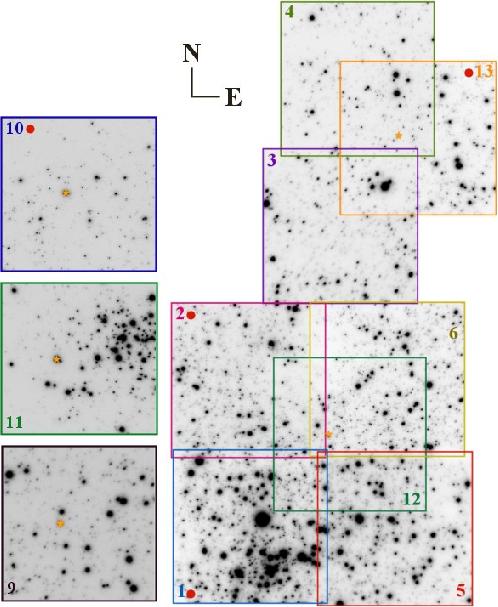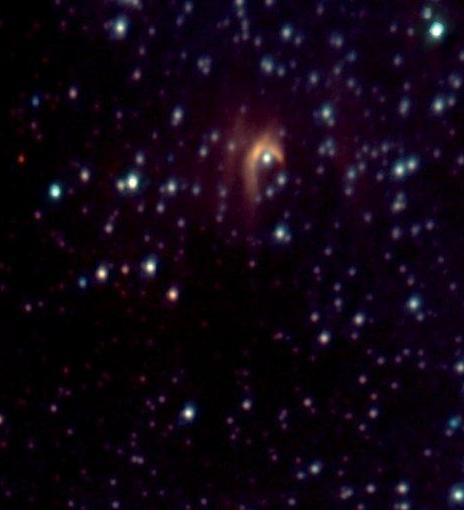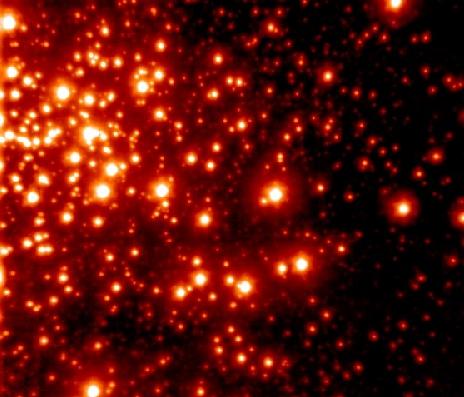
 GCNEWS
GCNEWS
A Newsletter for Galactic Center Research
This Volume was edited by Angela Cotera, Heino Falcke & Sera Markoff
email: gcnews@aoc.nrao.edu

 GCNEWS
GCNEWS


Angela Cotera1 & François
Rigaut2
(1Steward Observatory and 2Gemini Observatory)
During July and August 2000, the Galactic center was observed extensively as part of a program designed to demonstrate the capabilites of Gemini North, and more specifically, the results obtainable using adaptic optics on Gemini North. The data, which has been released for use by the scientific community, provides some of the deepest near-infrared images of the central parsec and Arches Cluster to date. The data was taken over several nights and generated images with a FWHM varying from 80-140 mas. CO observations of several of the fields were also obtained.
As part of the commissioning phase of Gemini North, two demonstration science programs were undertaken: one of the programs focused on the Galactic Center (GC). To establish the scientific goals for this program a science group was put together, involving members from the Gemini partner countries3. The science team discussed many observing options, and reached a consensus that the goals for the demonstration observations would be 1) to investigate the stellar population with the deepest images available over the largest practical area, 2) to study possible variability by monitoring a few fields over the two month observation period, 3) to use H and K images to map the structured extinction, and 4) to create a database that will be useful for future Gemini observations.
The observations were taken over several nights in July and August of this year. The observations were taken with the Hokupa'a adaptive optics (AO) system and the QUIRC infrared camera, both on loan from the University of Hawaii. Hokupa'a is based on a 36 element wavefront curvature correction, representing approximately a third of the elements which will eventually be available on the Gemini North telescope. QUIRC uses a 1024*1024 HAWAII HgCdTe array, which, when used with Hokupa'a, has a platescale 20 mas, for a field of view of 20''*20''. The observations were taken over many nights, under varying sky conditions. The FWHM of the point-spread-function (PSF) under the best conditions is 80 mas, with an typical FWHM of 140 mas. Since at Mauna Kea, the GC transits at 42o, all of the observations were taken at airmass between 1.5 and 2, which is an additional challenge for the AO system.
Data was taken at 11 positions, numbered 1 to 13 (with 7 and 8 missing for historical reasons): 10 of these positions are shown as with their relative offset in Figure 1. Positions 1-6, 12 and 13, are within the central 3 pc of the galaxy. Positions 9 and 10 were taken as control fields to allow for establishing the reference properties of the bulge background stellar population. These positions (J2000 coordinates RA 17h45m33.25s Dec -29o 2' 38.1'' and RA 17h45m40.82s -28o57'18.9'' respectively) were centered on an available AO guide star in the general area, to provide for the best possible wavefront corrections and the least amount of distortion across the array. Position 12 was centered on the central parsec guide star, overlapping fields 1,2,5 and 6, and was taken both for use in establishing astrometric registration and for photometric consistency for 4 central fields. Finally, field 11 is the Arches Cluster.

H and K' images are available for all fields; for some of the fields, H and/or K' or images were taken on several nights. CO and CO continuum have been taken for a few fields, which are labeled with the red dots in Figure 1. The original intent was to take CO for all fields, but this was not accomplished due to time constraints which resulted from a combination of bad weather, and both telescope and instrument engineering problems. All of the data have been reduced and released to the community. Information on how to obtain a copy of the data can be found at http://www.gemini.edu/sciops/data/dataSV.html. Additional details on the observations and information on the methodology employed for the data reduction are also available with the released data.
Already, the extent and clarity of the Gemini images has revealed new information on IRS 8 (see Figure 2). IRS 8 appears to be plowing through the dust and gas near the galactic center, creating an obvious bow-shock wave. In addition, the deepest image yet of the Arches Cluster has been obtained. In order minimize distortion across the array, introduced by the AO system, the AO star was placed in the center of the array. To insure good observational depth, the same position was repeated numerous times. Therefore, only a portion of the cluster was observed. The reduced image is shown in Figure 3. By using the AO system, and coadding many integrations, the Gemini data provide unprecedented resolution of the inner portions of the cluster and provide us with the ability to go measure numerous additional fainter stars. The data will undoubtably greatly improve our understanding of this cluster.
In addition to the sheer volume of released data, covering a much larger area than previously available, the primary advantage for those who utilize the Gemini data in their research will be the greatly improved point-spread-function (as compared with other publicly available data such as the HST NICMOS archival data). The resultant higher spatial resolution will permit investigations further down the main sequence, improving our understanding of the IMF in all the fields obtained. In conjunction with the reference fields, we will be able to investigate the variations in the stellar populations, greatly improving our understanding of the star formation history in this enigmatic region. Finally, this data set will provide an excellent baseline for future kinematic and variability investigations.

